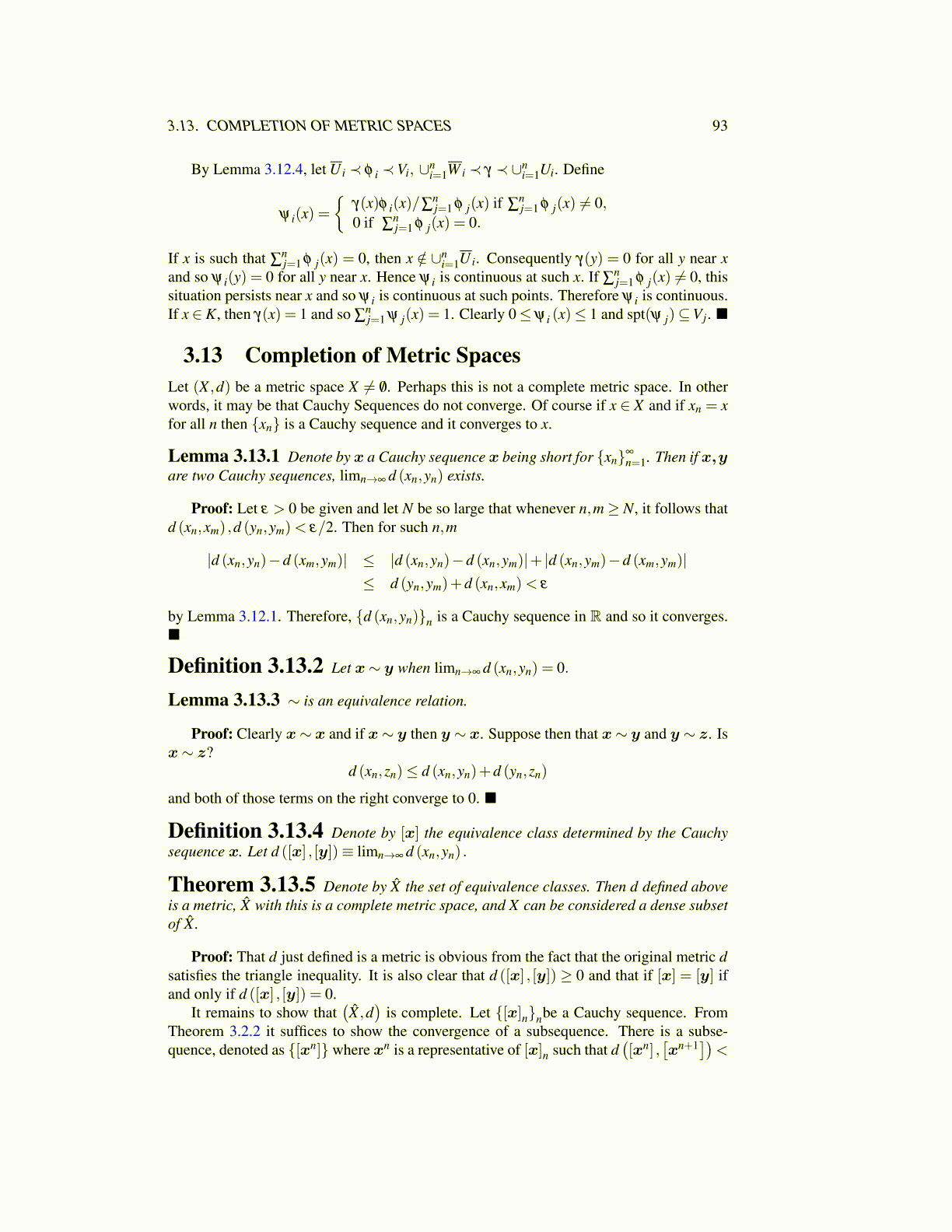
3.13. COMPLETION OF METRIC SPACES 93
By Lemma 3.12.4, let U i ≺ φ i ≺Vi, ∪ni=1W i ≺ γ ≺ ∪n
i=1Ui. Define
ψ i(x) ={
γ(x)φ i(x)/∑nj=1 φ j(x) if ∑
nj=1 φ j(x) ̸= 0,
0 if ∑nj=1 φ j(x) = 0.
If x is such that ∑nj=1 φ j(x) = 0, then x /∈ ∪n
i=1U i. Consequently γ(y) = 0 for all y near xand so ψ i(y) = 0 for all y near x. Hence ψ i is continuous at such x. If ∑
nj=1 φ j(x) ̸= 0, this
situation persists near x and so ψ i is continuous at such points. Therefore ψ i is continuous.If x ∈ K, then γ(x) = 1 and so ∑
nj=1 ψ j(x) = 1. Clearly 0≤ψ i (x)≤ 1 and spt(ψ j)⊆Vj. ■
3.13 Completion of Metric SpacesLet (X ,d) be a metric space X ̸= /0. Perhaps this is not a complete metric space. In otherwords, it may be that Cauchy Sequences do not converge. Of course if x ∈ X and if xn = xfor all n then {xn} is a Cauchy sequence and it converges to x.
Lemma 3.13.1 Denote by x a Cauchy sequence x being short for {xn}∞
n=1. Then if x,yare two Cauchy sequences, limn→∞ d (xn,yn) exists.
Proof: Let ε > 0 be given and let N be so large that whenever n,m≥ N, it follows thatd (xn,xm) ,d (yn,ym)< ε/2. Then for such n,m
|d (xn,yn)−d (xm,ym)| ≤ |d (xn,yn)−d (xn,ym)|+ |d (xn,ym)−d (xm,ym)|≤ d (yn,ym)+d (xn,xm)< ε
by Lemma 3.12.1. Therefore, {d (xn,yn)}n is a Cauchy sequence in R and so it converges.■
Definition 3.13.2 Let x∼ y when limn→∞ d (xn,yn) = 0.
Lemma 3.13.3 ∼ is an equivalence relation.
Proof: Clearly x∼ x and if x∼ y then y ∼ x. Suppose then that x∼ y and y ∼ z. Isx∼ z?
d (xn,zn)≤ d (xn,yn)+d (yn,zn)
and both of those terms on the right converge to 0. ■
Definition 3.13.4 Denote by [x] the equivalence class determined by the Cauchysequence x. Let d ([x] , [y])≡ limn→∞ d (xn,yn) .
Theorem 3.13.5 Denote by X̂ the set of equivalence classes. Then d defined aboveis a metric, X̂ with this is a complete metric space, and X can be considered a dense subsetof X̂ .
Proof: That d just defined is a metric is obvious from the fact that the original metric dsatisfies the triangle inequality. It is also clear that d ([x] , [y]) ≥ 0 and that if [x] = [y] ifand only if d ([x] , [y]) = 0.
It remains to show that(X̂ ,d
)is complete. Let {[x]n}nbe a Cauchy sequence. From
Theorem 3.2.2 it suffices to show the convergence of a subsequence. There is a subse-quence, denoted as {[xn]} where xn is a representative of [x]n such that d
([xn] ,
[xn+1
])<